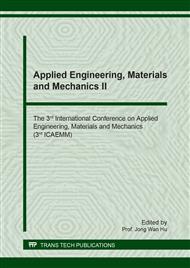p.271
p.278
p.287
p.292
p.299
p.305
p.311
p.316
p.323
Elastic Strength of Defective Steel Bolt Group under Eccentric Load Design
Abstract:
Steel bolt groups are often used for joining steel structures. The design strength of the steel bolt group is related to the geometric distribution, the eccentric load distance, the material strength and the load angle, thus making the analysis complicated and not easy for the user. The existing analysis methods are two kinds of elasticity and ultimate analysis. Both methods consider the stress distribution of each steel bolt and find the steel bolt at the critical position is obtained, the design load analysis is deduced. This study will consider the geometric distribution of steel bolting group affected, for a row, two rows, three rows and four rows of bolt group, considering different eccentric distance and angle of influence. Using a simple elastic analysis method to Studied the strength analysis results produced when a corner bolt is damaged due to a defect. The results show that the greater the eccentric load distance, the lower the design strength, and the load change on the vertical is more obvious than the horizontal. When the corner of the steel bolt group is removed, its design strength is likely to decrease, but at low eccentricity distance and large angles, the strength of the complete bolt is higher. This study organizes the design method of steel bolts and reviews the geometric rules of the bolt group analysis. It founded that the regular geometry needs to be reviewed in the case of large eccentric loads with small eccentricities. This study for the bolt connections strength of a certain understanding and awareness, expect the future for the safety of steel structure contribute.
Info:
Periodical:
Pages:
299-304
Citation:
Online since:
July 2018
Authors:
Keywords:
Price:
Сopyright:
© 2018 Trans Tech Publications Ltd. All Rights Reserved
Share:
Citation:


